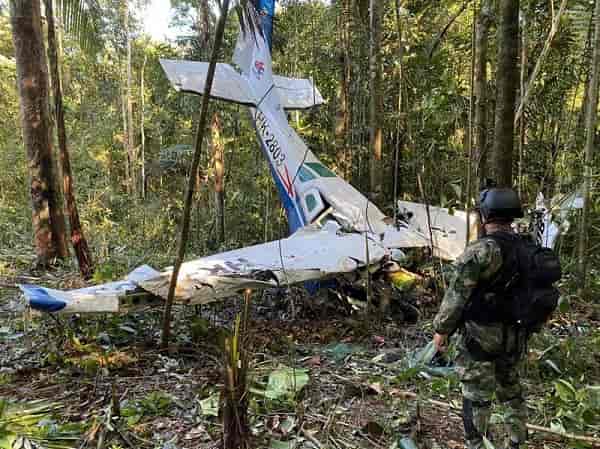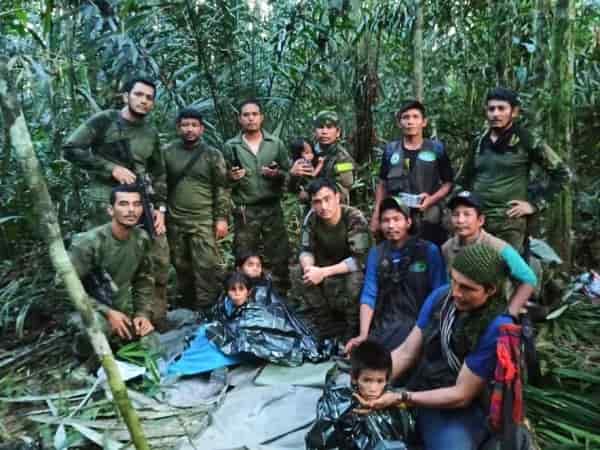The Mystery of the Children Missing in the Colombian Plane Crash

In 2023, the world was captivated by the incredible survival story of four Indigenous children who endured the unimaginable after their plane crashed in the Colombian Amazon. This heart-stopping event was not only a tragedy but also a tale of remarkable resilience, hope, and determination.
The children, ages ranging from 11 months to 13 years old, survived for 40 days in the jungle—one of the most hostile environments on Earth. Their story is a testament to human survival, family bonds, and the power of traditional knowledge.
The Tragic Crash: What Happened?
On May 1, 2023, a small Cessna 206 aircraft carrying seven people, including the four children, took off from Araracuara, a remote Indigenous community in the Amazonas department of southern Colombia. Their destination was San José del Guaviare, but tragedy struck shortly after takeoff when the plane encountered technical difficulties. The pilot reported engine failure, and the aircraft plummeted into the dense, unforgiving Amazon rainforest.
The crash killed three adults on board, including the children’s mother, the pilot, and another adult passenger. Miraculously, the children survived, but they were stranded in the heart of the jungle, miles from civilization and with no immediate rescue in sight.
The Survival Struggle: 40 Days in the Jungle
What followed was a 40-day ordeal that tested the children’s survival skills, both physically and mentally. With no food supply and only the natural resources around them, they relied on their upbringing and Indigenous knowledge of the forest. The eldest child, 13-year-old Lesly Jacobombaire, took on the role of protector for her younger siblings: 9-year-old Soleiny, 4-year-old Tien Noriel, and the 11-month-old Cristin.
The children survived on fruits, berries, and whatever they could forage. They also had to navigate the many dangers of the rainforest, including venomous snakes, wild animals, and insects, as well as the challenges of torrential rain and humidity. Their Indigenous heritage, rooted in the Huitoto culture, proved invaluable. The Huitoto people are known for their deep connection with the natural world and their extensive knowledge of the Amazon’s plants and animals. This knowledge, passed down from generation to generation, likely played a crucial role in the children’s survival.
The Search and Rescue Mission
The Colombian government, along with military forces and Indigenous trackers, launched an intensive search and rescue operation. The jungle, however, presented formidable obstacles, with thick foliage making aerial searches difficult and ground searches slow.
The rescue teams found the wreckage of the plane just two weeks after the crash, but there was no sign of the children. This discovery marked the beginning of a more desperate phase of the search, with authorities fearing the worst. Military personnel and Indigenous volunteers scoured the area for any signs of the children, but the vastness of the jungle meant the mission was akin to finding a needle in a haystack.

In this photo released by Colombia’s Armed Forces Press Office, soldiers and others pose for a photo on Friday with the four children who were missing after a deadly plane crash in the Solano jungle, Caqueta state, Colombia.
It wasn’t until June 9, 2023—40 days after the crash—that the children were found alive. A search party of Indigenous volunteers and Colombian military personnel spotted them in the Caquetá region, around five kilometers from the crash site. Despite being weak, dehydrated, and covered in insect bites, the children were alive and, against all odds, had survived one of the most grueling survival situations imaginable.
The Heroes: Indigenous Knowledge and Family Bonds
What makes this survival story truly extraordinary is how the children’s cultural heritage and familial bonds helped them pull through. Lesly, the eldest, displayed remarkable leadership and resourcefulness. Her knowledge of the jungle and ability to care for her siblings, even under the most extreme conditions, were critical to their survival.
Indigenous trackers, too, played a key role in the rescue mission. Using traditional tracking methods, they were able to follow subtle signs in the jungle, like broken branches and footprints, which eventually led to the discovery of the children.
The Aftermath: Recovery and Reflection
After their rescue, the children were immediately airlifted to a hospital for treatment. They were malnourished, weak, and traumatized, but they were alive—a miracle in itself. The incident drew global attention, with people hailing the children’s survival as a symbol of hope and resilience. Colombian President Gustavo Petro called it “an example of absolute survival that will be remembered in history.”
The story also raised awareness about the importance of Indigenous knowledge and the vital role it plays in survival situations. For the children, their knowledge of the jungle, passed down through generations, became their lifeline.
A Story of Survival That Will Be Remembered
The survival of the four Indigenous children in the Colombian Amazon in 2023 is a story that will resonate for years to come. Their ability to withstand the harshest of environments, coupled with their strong familial bonds and cultural knowledge, speaks to the incredible strength of the human spirit.
This event not only highlighted the resilience of children but also the critical importance of Indigenous cultures in today’s world. Their story is a reminder that, even in the face of overwhelming odds, survival is possible with courage, hope, and the support of one another.
FAQ: Children Who Survived the Colombian Plane Crash in 2023
1. What caused the Colombian plane crash in 2023?
The crash occurred due to engine failure shortly after the small Cessna 206 aircraft took off. The plane went down in the dense Amazon rainforest on May 1, 2023.
2. How many people were on board the plane?
There were seven people on board the plane, including three adults and four children.
3. Who survived the Colombian plane crash?
Four Indigenous children, ages 11 months to 13 years, miraculously survived the crash. The adults, including the children’s mother and the pilot, sadly did not survive.
4. How long did the children survive in the jungle?
The children survived for 40 days in the Colombian Amazon jungle before being rescued.
5. What helped the children survive in the jungle?
The children’s knowledge of the jungle, passed down from their Huitoto Indigenous culture, was essential to their survival. They foraged for fruits, avoided dangerous animals, and relied on their eldest sibling for leadership.
6. How were the children found?
After a massive search effort involving Colombian military forces and Indigenous trackers, the children were found alive on June 9, 2023, about five kilometers from the crash site.
7. What challenges did the children face while stranded in the jungle?
The children faced numerous dangers, including venomous snakes, wild animals, extreme weather, and the challenges of finding food and water.
8. What impact did the crash have on global awareness?
The survival story gained international attention, showcasing the importance of Indigenous knowledge and resilience. It also highlighted the unique challenges faced in rescue missions in dense jungle environments.
9. What is the significance of the children’s Indigenous background?
The children are part of the Huitoto Indigenous group, known for their deep understanding of the Amazon jungle. Their cultural knowledge of survival techniques was crucial to their endurance in the hostile environment.
10. What happened to the children after they were rescued?
The children were airlifted to a hospital, where they received treatment for malnutrition, dehydration, and insect bites. Despite the physical and emotional trauma, they were reported to be recovering well after their ordeal.
